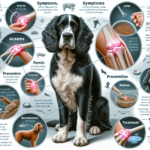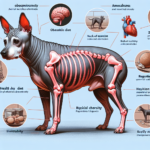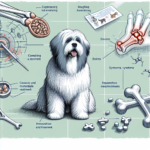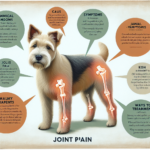Irish Water Spaniel Joint Pain: Causes, Symptoms, Prevention, and Treatment

Introduction
The Irish Water Spaniel is a distinctive and versatile breed known for its curly, water-resistant coat and exceptional swimming abilities. Originating from Ireland, this breed has a rich history as a hunting and retrieving dog, particularly adept at working in water. With a unique appearance characterized by a topknot of curls on the head and a smooth “rat tail,” the Irish Water Spaniel is both striking and functional. Despite their robust nature, these dogs are prone to certain health issues, with joint pain being a significant concern.
Joint health is crucial for the Irish Water Spaniel due to their active lifestyle and working heritage. Maintaining healthy joints ensures that these dogs can continue to perform their duties and enjoy a high quality of life. This article will delve into the causes, symptoms, prevention, and treatment of joint pain in Irish Water Spaniels, providing a comprehensive guide for owners to keep their pets healthy and active.
Breed-Specific Joint Pain Risks
Genetic Predisposition
Irish Water Spaniels, like many purebred dogs, have a genetic predisposition to certain joint-related issues. Hip dysplasia, a condition where the hip joint doesn’t fit properly into the hip socket, is relatively common in this breed. Elbow dysplasia, where the elbow joint is malformed, can also occur. Both conditions can lead to arthritis and chronic pain if not managed properly.
Age-Related Risks
As Irish Water Spaniels age, the risk of developing joint pain increases. Degenerative joint diseases such as osteoarthritis are more likely to appear in older dogs. Owners should be vigilant about changes in their dog’s mobility and comfort, particularly as they reach middle age (around 6-8 years) and beyond.
Activity Level and Joint Stress
Irish Water Spaniels are known for their high energy levels and love of physical activity. While regular exercise is essential for their overall health, excessive or inappropriate exercise can put undue stress on their joints. Activities that involve a lot of jumping or sudden stops and starts can be particularly hard on their joints, potentially leading to injuries and long-term joint issues.
Common Symptoms of Joint Pain in Irish Water Spaniels
General Symptoms
- Limping: One of the most noticeable signs of joint pain is limping or favoring one leg over another.
- Stiffness: Dogs may show stiffness, especially after resting or sleeping.
- Reluctance to Move: A dog in pain may be hesitant to engage in activities they once enjoyed, such as running, jumping, or climbing stairs.
- Swelling: In some cases, the affected joint may appear swollen or feel warm to the touch.
- Behavioral Changes: Dogs in pain may become irritable, less active, or show signs of depression.
Breed-Specific Symptoms
In Irish Water Spaniels, joint pain may manifest in specific ways due to their unique build and activity patterns. Owners might notice a decrease in their dog’s enthusiasm for water activities or retrieving games. Additionally, the breed’s characteristic “rat tail” might be held differently if the dog is experiencing discomfort in the hip or lower back area.
When to Consult a Vet
If you observe any of the above symptoms in your Irish Water Spaniel, it’s essential to consult a veterinarian promptly. Early diagnosis and intervention can significantly improve the prognosis and quality of life for dogs with joint pain. Persistent limping, noticeable discomfort, or any sudden changes in behavior warrant a professional evaluation.
Preventive Measures for Joint Health
Exercise Recommendations
Regular, moderate exercise is crucial for maintaining joint health in Irish Water Spaniels. Activities such as swimming, which is low-impact and easy on the joints, are ideal. Avoid high-impact exercises like excessive jumping or running on hard surfaces. Instead, focus on controlled activities that build muscle strength and support joint stability.
Dietary Suggestions
A balanced diet rich in essential nutrients can support joint health. Look for dog foods that contain glucosamine and chondroitin, which help maintain cartilage health. Omega-3 fatty acids, found in fish oil supplements, can reduce inflammation and support joint function. Always consult your veterinarian before adding supplements to your dog’s diet.
Weight Management
Maintaining a healthy weight is critical for reducing joint stress. Overweight dogs are at a higher risk of developing joint issues due to the extra load on their joints. Regularly monitor your dog’s weight and adjust their diet and exercise routine as needed to keep them within a healthy weight range.
Early Screening and Monitoring
Regular veterinary check-ups are essential for early detection of joint issues. For Irish Water Spaniels, consider screening for hip and elbow dysplasia, especially if you plan to breed your dog. Early diagnosis allows for timely intervention, which can slow the progression of joint diseases and improve your dog’s quality of life.
Treatment Options for Joint Pain
Non-Surgical Treatments
Non-surgical treatments for joint pain include medications such as non-steroidal anti-inflammatory drugs (NSAIDs) to reduce pain and inflammation. Physical therapy can also be beneficial, helping to strengthen the muscles around the joints and improve mobility. Lifestyle adjustments, such as modifying exercise routines and providing supportive bedding, can also alleviate symptoms.
Surgical Options
In severe cases, surgical intervention may be necessary. Common surgeries for joint pain include hip replacement, arthroscopy to remove damaged tissue, and joint fusion. These procedures can significantly improve a dog’s quality of life but come with risks and require a recovery period. Consult with a veterinary orthopedic specialist to determine the best course of action for your dog.
Alternative Therapies
Alternative treatments such as acupuncture, hydrotherapy, and massage can provide additional relief for dogs with joint pain. Acupuncture can help reduce pain and inflammation, while hydrotherapy offers low-impact exercise that strengthens muscles without stressing the joints. Massage therapy can improve circulation and reduce muscle tension, providing comfort to dogs with chronic pain.
Lifestyle and Management Tips
Daily Care Routine
A consistent daily care routine can help manage joint pain in Irish Water Spaniels. Start with gentle morning exercises to loosen stiff joints, followed by a balanced diet rich in joint-supporting nutrients. Incorporate regular, low-impact activities like swimming or controlled walks, and provide plenty of rest periods throughout the day.
Modifying the Home Environment
Making your home more comfortable for a dog with joint pain can significantly improve their quality of life. Consider installing ramps to help them navigate stairs or get onto furniture. Provide orthopedic beds that offer better support for their joints. Ensure that food and water bowls are at a comfortable height to reduce strain on their neck and back.
Long-Term Management
Long-term management of joint pain involves regular veterinary check-ups, consistent weight management, and ongoing physical therapy or alternative treatments as needed. Keep a close eye on your dog’s behavior and mobility, adjusting their care routine as necessary to ensure they remain active and comfortable.
FAQs About Irish Water Spaniels and Joint Pain
What are the early signs of joint pain in Irish Water Spaniels?
Early signs include limping, stiffness, reluctance to move, and behavioral changes such as irritability or decreased activity levels.
Can joint pain in Irish Water Spaniels be prevented?
While genetic predispositions cannot be entirely prevented, maintaining a healthy weight, providing appropriate exercise, and regular veterinary check-ups can significantly reduce the risk and severity of joint pain.
Are there specific diets that can help with joint health?
Yes, diets rich in glucosamine, chondroitin, and omega-3 fatty acids can support joint health. Consult your veterinarian for specific dietary recommendations.
When should I consider surgery for my dog’s joint pain?
Surgery should be considered when non-surgical treatments are no longer effective, and the dog’s quality of life is significantly impacted. A veterinary orthopedic specialist can provide guidance on the best surgical options.
What alternative therapies are effective for joint pain in dogs?
Alternative therapies such as acupuncture, hydrotherapy, and massage can provide additional relief and improve mobility for dogs with joint pain.
Conclusion
Joint pain is a significant concern for Irish Water Spaniels, given their active lifestyle and genetic predispositions. By understanding the causes, symptoms, prevention, and treatment options, owners can take proactive steps to ensure their dogs maintain healthy joints and enjoy a high quality of life. Regular veterinary check-ups, appropriate exercise, a balanced diet, and weight management are crucial components of joint health. If joint pain does occur, a combination of medical treatments, lifestyle adjustments, and alternative therapies can provide relief and improve your dog’s comfort and mobility. Always consult with your veterinarian to develop a comprehensive care plan tailored to your dog’s specific needs.




